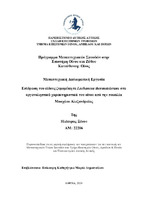| dc.contributor.advisor | Δημοπούλου, Μαρία | |
| dc.contributor.author | Ξένου, Ηλέκτρα | |
| dc.date.accessioned | 2024-07-05T08:12:16Z | |
| dc.date.available | 2024-07-05T08:12:16Z | |
| dc.date.issued | 2024 | |
| dc.identifier.uri | https://polynoe.lib.uniwa.gr/xmlui/handle/11400/6959 | |
| dc.identifier.uri | http://dx.doi.org/10.26265/polynoe-6794 | |
| dc.description.abstract | Η παρούσα εργασία εκπονήθηκε στο εργαστήριο Βιοχημείας & Βιοτεχνολογίας στο τμήμα Επιστημών Οίνου, Αμπέλου και Ποτών του Πανεπιστημίου Δυτικής Αττικής. Αντικείμενο της παρούσας εργασίας είναι η μελέτη της δράσης διαφορετικών ειδών ζυμών (Saccharomyces και non-Saccharomyces) και συνθηκών εμβολιασμού στην κλασσική λευκή οινοποίηση από σταφύλια Vitis vinifera της ποικιλίας Μοσχάτο Αλεξανδρείας στα οργανοληπτικά χαρακτηριστικά των παραγόμενων οίνων. Οι ζυμομύκητες που χρησιμοποιήθηκαν ήταν οι Saccharomyces cerevisiae και Lachancea thermotolerans. Οι διαφορετικές συνθήκες εμβολιασμού που εφαρμόστηκαν ήταν: εμβολιασμός με μονοκαλλιέργεια στελέχους S. cerevisiae (συνθήκη Α), ταυτόχρονος συνεμβολιασμός του στελέχους S. cerevisiae και L. thermotolerans (συνθήκη Β) και τέλος διαδοχικός εμβολιασμός του στελέχους L. thermotolerans που ακολουθήθηκε από εμβολιασμό με το στέλεχος του S. cerevisiae 48 ώρες μετά (συνθήκη C). Η κάθε συνθήκη εμβολιασμού πραγματοποιήθηκε σε τριπλή βιολογική επανάληψη. Αρχικά έγινε η κινητική της αλκοολικής ζύμωσης, ενώ στους παραγόμενους οίνους πραγματοποιήθηκαν οι βασικές οινολογικές αναλύσεις. Έπειτα, ακολούθησε οργανοληπτική αξιολόγηση των οίνων. Η οργανοληπτική αξιολόγηση χωρίστηκε σε δύο μέρη. Στο πρώτο μέρος έλαβε χώρα η περιγραφική οργανοληπτική αξιολόγηση και οι οίνοι αξιολογήθηκαν στη μύτη και στο στόμα με βάση τα πρωτογενή χαρακτηριστικά της ποικιλίας, τα δευτερογενή αρώματα της ζύμωσης και τα ιδιαίτερα χαρακτηριστικά της ζύμης που χρησιμοποιήθηκε. Επίσης, ζητήθηκε από τα άτομα του πάνελ εκτίμηση της ποικιλίας των σταφυλιών που χρησιμοποιήθηκαν. Το δεύτερο μέρος αφορούσε δύο τεστ τριγωνικής δοκιμής. Στο τεστ αυτό, και στις δύο περιπτώσεις, το διαφορετικό δείγμα ήταν ο οίνος της συνθήκης C. Τα ίδια δείγματα ήταν της συνθήκης Α και της συνθήκης Β στο πρώτο και στο δεύτερο τεστ αντίστοιχα.
Με βάσει τα αποτελέσματα, η επίδραση του στελέχους L. thermotolerans στα χαρακτηριστικά του τελικού οίνου είναι άμεσα συνυφασμένη με τον τρόπο εμβολιασμού. Πιο συγκεκριμένα, ο διαδοχικός εμβολιασμός του είδους L. thermotolerans με τον S. cerevisiae φάνηκε να μειώνει τη συγκέντρωση σε αλκοόλη, να αυξάνει την ολική οξύτητα και να έχει τη τάση να αυξάνει τα τροπικά αρώματα, την βοτανικότητα, την αρωματική ένταση και επίγευση των οίνων. Συμπερασματικά ο χρόνος εμβολιασμού παίζει σημαντικό ρόλο στην αλληλεπίδραση των δύο ειδών και στο τελικό αποτέλεσμα. | el |
| dc.format.extent | 88 | el |
| dc.language.iso | el | el |
| dc.publisher | Πανεπιστήμιο Δυτικής Αττικής | el |
| dc.rights | Αναφορά Δημιουργού - Μη Εμπορική Χρήση - Παρόμοια Διανομή 4.0 Διεθνές | * |
| dc.rights | Attribution-NonCommercial-NoDerivatives 4.0 Διεθνές | * |
| dc.rights | Attribution-NonCommercial-NoDerivatives 4.0 Διεθνές | * |
| dc.rights | Attribution-NonCommercial-NoDerivatives 4.0 Διεθνές | * |
| dc.rights | Attribution-NonCommercial-NoDerivatives 4.0 Διεθνές | * |
| dc.rights | Attribution-NonCommercial-NoDerivatives 4.0 Διεθνές | * |
| dc.rights | Attribution-NonCommercial-NoDerivatives 4.0 Διεθνές | * |
| dc.rights.uri | http://creativecommons.org/licenses/by-nc-nd/4.0/ | * |
| dc.subject | Μοσχάτο Αλεξανδρείας | el |
| dc.subject | Λευκή οινοποίηση | el |
| dc.subject | Saccharomyces cerevisiae | el |
| dc.subject | Lachancea thermotolerans | el |
| dc.subject | Τεστ τριγωνικής δοκιμής | el |
| dc.subject | Περιγραφική οργανοληπτική αξιολόγηση | el |
| dc.subject | Non-Saccharomyces | el |
| dc.title | Επίδραση του είδους ζυμομύκητα Lachancea thermotolerans στα οργανοληπτικά χαρακτηριστικά του οίνου από την ποικιλία Μοσχάτο Αλεξανδρείας | el |
| dc.title.alternative | Effect of the yeast species Lachancea thermotolerans on the sensory characteristics of wine from the variety Muscat of Alexandria | el |
| dc.type | Μεταπτυχιακή διπλωματική εργασία | el |
| dc.contributor.committee | Arapitsas, Panagiotis | |
| dc.contributor.committee | Ντουρτόγλου, Ευθαλία | |
| dc.contributor.faculty | Σχολή Επιστημών Τροφίμων | el |
| dc.contributor.department | Τμήμα Επιστημών Οίνου, Αμπέλου και Ποτών | el |
| dc.contributor.master | Επιστήμη Οίνου και Ζύθου | el |
| dc.description.abstracttranslated | The present work was carried out in the Laboratory of Biochemistry & Biotechnology at the Department of Wine, Vine and Beverage Sciences of the University of West Attica. The aim of the present work is to study the effect of different yeast species (Saccharomyces and non-Saccharomyces) and inoculation conditions in classical white vinification from Vitis vinifera grapes of the variety Muscat of Alexandria on the organoleptic characteristics of the wines produced. The yeasts used were Saccharomyces cerevisiae and Lachancea thermotolerans. The different inoculation conditions applied were: inoculation with monoculture S. cerevisiae strain (condition A), simultaneous co-inoculation of S. cerevisiae strain and L. thermotolerans strain (condition B) and finally sequential inoculation of L. thermotolerans strain followed by inoculation with S. cerevisiae strain 48 hours later (condition C). Each inoculation condition was carried out in a triple biological replicate. Initially, the kinetics of alcoholic fermentation was carried out while the basic oenological analyses were carried out on the wines produced. This was followed by a sensory evaluation of the wines. The sensory evaluation was divided into two parts. In the first part, a descriptive sensory evaluation took place and the wines were evaluated on the nose and in the mouth based on the primary characteristics of the variety, the secondary aromas of fermentation and the specific characteristics of the yeast used. In addition, the panelists were asked to estimate the variety of grapes used. The second part involved two triangular tasting tests. In this test, in both cases, the different sample was the wine of condition C. The same samples were of condition A and condition B in the first and second tests respectively.
Based on the results, the effect of the L. thermotolerans strain on the characteristics of the final wine is directly linked to the method of inoculation. More specifically, sequential inoculation of L. thermotolerans with S. cerevisiae was shown to reduce alcohol concentration, increase total acidity and tend to increase tropical aromas, herbalism, aromatic intensity and aftertaste of the wines. In conclusion, the time of inoculation plays an important role in the interaction of the two species and in the final result. | el |



